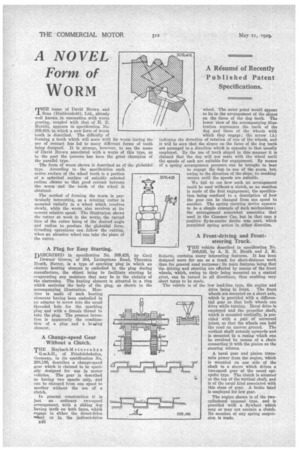A NOVEL Form of WORM
Page 72

If you've noticed an error in this article please click here to report it so we can fix it.
MHE name of David Brown and
Sons (Huddersfield), Ltd., already well known. in connection with worm gearing, coupled with that of H. E. Merritt, appears in specification No. :.109,418, in which a new form of worm tooth is described. The difficulty of forming a tooth which will mate with its worm 'during the are of contact bas led to many different forms of tooth being designed. It is strange, however, to see the name of David Brown associated with a worm of this type, as in the past the concern has been the great champion of the parallel type.
The form of worm shown is described as of the globoidal type. According to the specification each active surface of the wheel tooth is a portion of a spherical surface of suitably selected radius, chosen so that good' contact between theworm and the tooth of the wheel is obtained.
The method of forming the worm is particularly interesting, as a rotating cutter' is mounted radially in a wheel which revolves slowly, while the worm also revolves at its correct relative speed. The illustration shows the cutter at work in the worm, the curved face of the cutter being of the desired angle and radius to produce the globoidaI form. Grinding operations can follow the cutting. when 'an abrasive wheel can take the place of the cutter.
A Plug for Easy Starting. •
DESCRIBED in specification No. 309,428, by Cecil
Downer Groves," of 204, Livingstone Road, Thornton Heath, Surrey, is a type of sparking plug in which an eleetric heating element is embodied in the plug during manufacture, the object being to facilitate starting by evaporating any moisture that may be in the vicinity of the electrodes. The heating element is situated in a ring which encircles the 'body of the plug, as shown in the accompanying illustration. Mention is made of such heating elements having been embodied in an adapter to screw into the usual threaded hole for the sparking plug and with a female thread to take the plug. The present invention is apparently the combination of a plug and a he:ting element.
A Change-speed Gear Without a Clutch.
THE Maybach-M o torenb au
G.m.b.H., of Priedrichshafen, Germany, in its specification No. 208,186, describes a change-speed gear which is claimed to be specially designed for use in motor vehicles. The gear is described as having two speeds only, and can be changed from one speed to another without the use of a clutch.
In general construction it is just an ordinary two-speed arrangement, with a sliding dog having teeth on both faces, which engage in either the direct-drive "heel or in the indirect-drive B46
wheel. The novel point would appear to lie in the arrangement of the slopes on the faces of the dog teeth. The lower view of the accompanying illustration represents the teeth of the dog and those of the wheels with which they engage ; the arrow (A) indicates the direction of rotation of one of the wheels, and it will be seen that the slopes on the fares of the dog teeth are arranged in a direction which is opposite to that usually employed. By the use of teeth sloped in this manner it is claimed that the dog will not mate with the wheel until the speeds of each are suitable for engagement. By means of a spring arrangement pressure can be brought to hear to engage the dog'. in one of the gears, but, owing to the direction of the slope, no meshing occurs until the speeds are suitable.
We fail to Lee how such an arrangement could be used without a clutch, as no mention is made of the first engagement, the specification being confined to a description of how the gear can be changed from one speed to another. The spring centring device appears to be a simple example of such mechanisms ; the arrangement somewhat resembles that used in the Commer Car, but in that case a positive 11y-to-centre device was used, which permitted spring action in either direction.
A Front-driving and Frontsteering Truck.
TEE vehicle described in specification No. 308,636, by A. R. N. Heath and J. M. Roberts, contains many interesting features. It has been designed more for use as a truck for short-distance work than for general road purposes: its main features being that the driving-and steering are effected by means of the front wheels, which, owing to their being mounted on a central pivot, can be turned in all directions, thus enabling very short turns to be made.
The vehicle is of the low load-line type, the engine and drive being in front. The front wheels are mounted on a short axle, which is provided with a differential gear so that both wheels can drive while turning. Bevel drive is employed and the propeller shaft, which is mounted vertically, is provided with a pair of universal joints, so that the wheels can hold the road on uneven ground. The vertical shaft extends upwards and is mounted in a. casing which can be revolved by means of a chain connecting it with the pinion on the steering column.
.0i, bevel gear and pinion transmits power from the engine, which is mounted on one side of the shaft to a sleeve which drives a two-speed gear of the usual epicyclic type. The clutch is situated at the top of the vertical shaft, and is of the usual kind associated with this class of gear. A brake band
is employed for low gear. '
The engine shown is of the two-. cylindered opposed type, and is provided with a flywheel which may or may not contain a clutch. No mention of any spring suspension is made.




















































































































